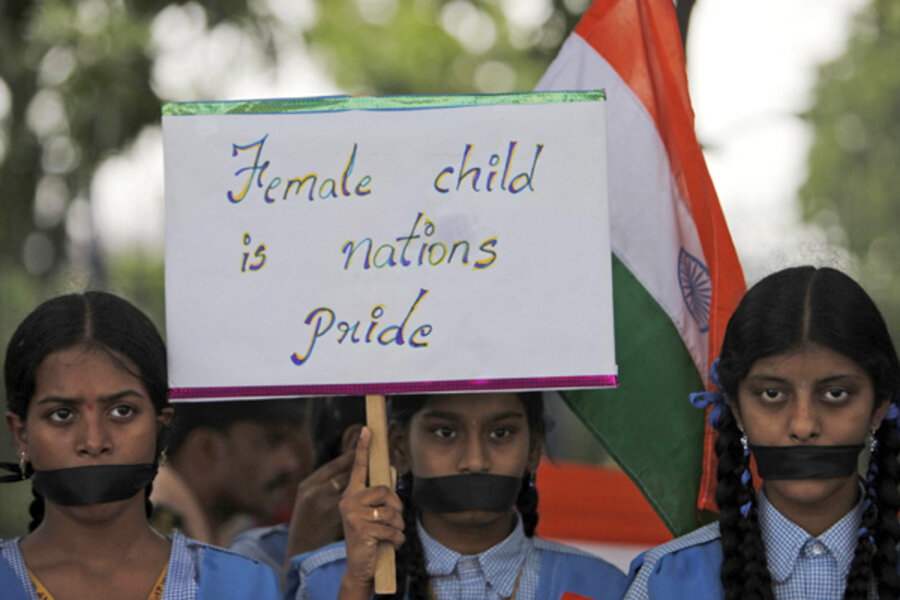Advocates begin to tackle India's child rape problem
| New Delhi
In the space of just 13 days last month, three separate reports of horrific rapes on young children brought widespread rage and condemnation in India, prompting protests in the capital and other cities.
The latest child rape incidents come on the heels of the case of a young woman who was gang raped on a Delhi bus and then tossed naked into the streets and left to die.
Now, child health experts warn that the recent cases of child rape highlight that child sex abuse is reaching “epidemic proportions.” Some 48,338 children reporting being raped in India between 2001 and 2011, according to a report by the Asian Centre for Human Rights (ACHR), and that number is going up.
"The December attack led to public outrage, which was good. The political classes are now responding, and even though it might be in platitudes, it means that things are moving," says Meenakshi Ganguly, the South Asia director of Human Rights Watch. But “child sex abuse remains widespread but hidden."
According to the National Crime Records Bureau, the number of child rapes registered in India in 2011 was just over 7,000 – a 30 percent increase over the previous year. Some of that increase may indicative of an increase in reporting, which is a good thing, says Ms. Ganguly. But most likely the number of incidents is still quite under-reported.
"India hasn't suddenly become a country full of pedophiles. It's something that's always been there," she says.
Swept under the carpet
Reticence toward discussing sex, combined with the practice of linking a young woman’s honor to her virginity, have often meant that complaints of molestation are swept under the carpet.
Krinna Shah, a program director at the New Delhi-based nongovernmental organization, Haq Centre for Child Rights, says there has long been a culture of silence surrounding sex abuse of minors.
"We don't discuss sex; not in schools, not in homes," says Ms. Shah, who works directly with affected children and families. "If a child comes to an adult and says, these things have been happening to me, the first instinct is denial."
Much of India remains deeply patriarchal. Decades of a widening male-female ratio means that many hundreds of thousands, even millions, of Indian men will not marry. Some commentators point out that increasing rural-to-urban migration high rates of mobile phone-accessed pornography are also factors leading to sexual violence against women and children.
Others suggest the movies and media don’t help, as Bollywood films have long glorified deeply entrenched gender stereotypes and the romantic pursuit of reluctant women – behavior that in real life would be considered stalking.
With little research beyond anecdotal evidence, it is difficult to say just how much of an impact any of these issues might actually have in the prevalence of sex attacks on children. But it is easy to see that children are at risk across all social strata – and those from lower-income families with both parents working are particularly vulnerable.
'Disturbingly common'
Human Rights Watch in February released a report into child sex abuse in India, which found that the phenomenon is "disturbingly common," especially in state institutions such as orphanages.
The report, “Breaking the Silence: Child Sexual Abuse in India,” found that India has major shortcomings in both state and community responses. In particular, it highlighted that reporting the incident to police, inappropriate medical examinations and lengthy court processes are often just as traumatic as the abuse.
The report also found that the most frequent abusers are neighbors or family members, something that is compounded by a lack of awareness. “Children are often unable to understand what's actually happening to them," says Ganguly.
Krinna Shah agrees, citing numerous examples of cases she has dealt with, in which children blithely talk about what has been done to them, indicating they don’t understand the gravity of it nor their rights.
The shift
But, say analysts, a shift toward rejection of such abuse is under way.
The December gang rape and subsequent death of a young woman in New Delhi became a tipping point in Indian attitudes toward sexual assault. For the first time, newspaper editorials deeply questioned whether wider attitudes toward women in India played a role – and prompted a prolonged, national discussion.
Almost a year ago, the Indian parliament passed the Protection of Children Against Sexual Offences Bill 2011, which seeks to protect children from abuse and introduce provisions to improve distressing and invasive medical procedures and lengthy court cases in cases of alleged rape. Experts say the legislation is starting to be implemented, although remains new and many provisions are still being interpreted.
"It's a good law but it really depends on how it is used. It calls for counseling and systems to be put in place to protect the child, as well as special child-friendly courts. But it's up to state governments to actually put these in place," says Ganguly.
Experts have suggested strong government measures to help turn the tide and provide protection for vulnerable children. A major step, they say, would be establishing government-run daycare in low-income communities. That would help keep children who aren't at school in a place that is safe while their parents are working, often up to 12 hours a day. In particular, single parents need financial support and access to childcare.
Perhaps most important, say advocates, is a recommendation to educate and empower children on personal safety and their rights when it comes to their own bodies, and convince families of the need to speak out. In a society only starting to come to terms with its often contradictory messages about sex, say healthcare workers, basic acts like these could help prevent the violence from occurring in the first place.





